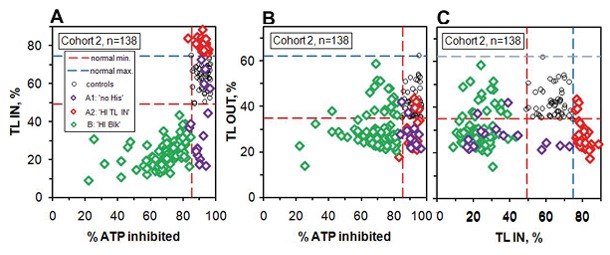Diseases/Conditions
Chronic Fatigue Syndrome: Study Proves Defective Cellular Energy Function
Sufferers of CFS/ME can now state unequivocally to their doctors that their symptoms are not in their heads, that they suffer from a mitochondrial dysfunction. They can refer their doctors to this study & ask them to do the proper testing.
For years, sufferers of chronic fatigue syndrome (CFS), also known as myalgic encephalomyelitis (ME), have been subjected to the abuse of modern medicine, which has claimed that it’s a mental disorder, that it’s all in their heads. Now, a clinical study clearly documents that these people, mostly women, suffer from a dysfunction of mitochondria, the cells’ energy production centers.
Published 30 June 2012 in the Journal of Clinical and Experimental Medicine, the study(1) investigated the use of biomedical tests to diagnose and expand knowledge of CFS/ME. They tested 139 patients diagnosed with CFS/ME and 53 normal healthy people. The subjects donated blood samples for an ATP Profile test carried out on neutrophils from a 3 milliliter blood sample. In a press release(2), the authors state they found:
- All patients tested have measureable mitochondrial dysfunction which correlates with the severity of the illness.
- The patients divide into two main groups differentiated by how cellular metabolism attempts to compensate for the dysfunction.
- Comparisons with exercise studies suggest that the dysfunction in neutrophils also occurs in other cells. This is confirmed by the cell-free DNA measurements which indicate levels of tissue damage up to 3.5 times the normal reference range.
- The major immediate causes of the dysfunction are lack of essential substrates and partial blocking of the translocator protein sites in mitochondria.
- The ATP Profile is a valuable diagnostic tool for the clinical management of CFS/ME.
Validity of the Study
So often today, studies can better be called pseudo science than true science, so we need to investigate the validity of this one. Did the authors do an honest study? Are their conclusions justified by their results?
- The study itself is simple. They took blood samples and subjected all to the same kind of test. That’s a good sign, indicating that there’s no likely attempt at deception.
- Some tests confound results by finding excuses to handle different people in different manners, or use complex statistics, which can readily disguise the results. Those things were not done.
- They compared the results with those of a previously tested CFS/ME group to see if they’re consistent. This helps rule out inconsistencies in the study.
- All of the results are provided, which is certainly a good indication.
- Several different factors are measured, and all are consistent with the claims.
- The degree of defect found closely correlates with the severity of disease.
- Honesty. The authors point out the limitations of their results:”We should still be cautious because of the small sample sizes and because no mildly ill patients were tested. Within these limitations the ATP profile is an inclusive and sensitive test for ME/CFS. However, we cannot cl aim that it is specific to ME/CFS because there are other neurological illnesses and metabolic syndromes associated with mitochondrial dysfunction.”
Whether the ATP profile also picks up people suffering from other chronic conditions, the study vindicates CFS/ME sufferers. They are, indeed, dealing with a clinical disease.
Study Results
Rather than present all the details of the study, one section of it is reported here to give a sense of what was done. For those who wish, the entire paper can be read here.
Mitochondria are a cell’s furnace. They produce energy in the form of ATP. The graphs below show measures of ATP functionality. TL refers to the translocator protein, which is responsible for transporting ADP, the precursor of ATP, into mitochondria and transporting ATP out. Thus TL IN refers to the amount of ADP that enters the mitochondria and TL OUT refers to the amount of ATP that exits.
Cohort 2 refers to the subjects who were studied. (This result does not include Cohort 1, the previous study group, though they’re included in other results.) Cohort 2 also includes the 53 control subjects:
- Controls – Circles
- Group A1: ”no His” – Subjects who don’t fit A2 or B definitions, Purple Diamonds
- Group A2: HI TL IN” – Subjects with higher than normal TL IN, Red Diamonds
- Group B: “Hi Blk” – Subjects with depressed ATP, Green Diamonds
 These graphs show the results of:
These graphs show the results of:
- Graph A: The amount of suppression of ADP entering mitochondria (TL IN) graphed against ATP inhibition in the different groups.
- Graph B: The amount of inhibition of ATP production (TL OUT) against ATP inhibition in the different groups.
- Graph C: Where the different groups fall in terms of TL OUT and TL IN.
Notice that in Graph A, those with the highest TL IN (red)—that is movement of ATP’s precursor, ADP—also have the greatest inhibition of ATP, indicating that the body is attempting to bring ATP production to normal levels, but without success. Likewise, those with the least suppression of ATP (green), correlate with the lowest TL IN. Notice that all of Group A (red and purple) fall into the highest levels of ATP inhibition. All of the controls fall within the normal range for TL IN and ATP inhibitiion, indicating their normal energy production.
Graph B is similar in results, but uses TL OUT (indicating amount of ATP transported out of the mitochondria) as a comparator.
Graph C compares TL IN with TL OUT. Notice that none of the controls (circles) are outside the 55-75% normal range, while all of the patients diagnosed with CFS/ME (red, green, and purple) fall outside the normal range. The authors state this “suggests that it is mainly the TL sites that are blocked.” They have identified a particular area of dysfunction with this test.
As a result of this study, the authors say that they can now use these tests to more accurately and with reliability define whether a patient’s condition is moderate, severe, or very severe. They have, in fact, replaced these categories with A1 (moderate), A2 (severe), and B (very severe).
Dr. Sarah Myhill Vindicated, Too
Dr. Sarah Myhill has been hounded by the General Medical Council (GMC) for years for her steadfast work to benefit her CFS/ME patients. They have exceptional trust in her, and many have been fearful of being left without her care because of the GMC’s tribunals against her.
Myhill is one of the three authors of the paper.
Over two years ago in Doc Who Harms No One Is Punished, But Docs Who Killed Can Practice, I stated:
The more I look at this case, the more clear it becomes that Dr. Myhill is being persecuted for holding views outside mainstream corrupt medicine. She is not a full supporter of vaccinations. Pharmaceuticals are not the first thing she considers in treatment. She thinks about what she does, rather than following the party line. Those are unacceptable qualities in modern medicine, and any doctor, no matter how well qualified, can expect to be punished for them.
Now, if there’s one whit of honesty at the GMC and the rest of the UK medical cabal, one can hope that Dr. Myhill will be left alone to do what she does better than anyone else: care for the patients who need her.
Graphic from FreeDigitalPhotos.net
Sources:
- (1)Mitochondrial dysfunction and the pathophysiology of Myalgic Encephalomyelitis/Chronic Fatigue Syndrome (ME/CFS)
- (2)Breaking news: ME/CFS & severity definitively linked to mitochondrial dysfunction, cellular damage
Tagged cfs, cfs study, cfs/me, chronic fatigue syndrome, me, Mitochondrial dysfunction, Mitochondrial dysfunction and the pathophysiology of Myalgic Encephalomyelitis/Chronic Fatigue Syndrome (ME/CFS), myalgic enceophalopathy, myhill cfs study, natural health, sarah myhill cfs study, sarah myhill gmc, sarah myhill me study, science
Related Posts
-
andrewkewley
-
http://www.facebook.com/steven.blake1 Steven Blake
-
airmikey1
















